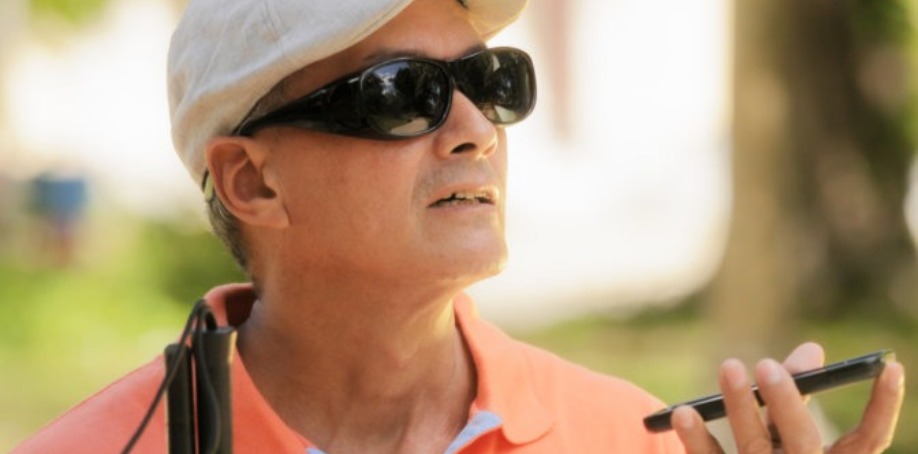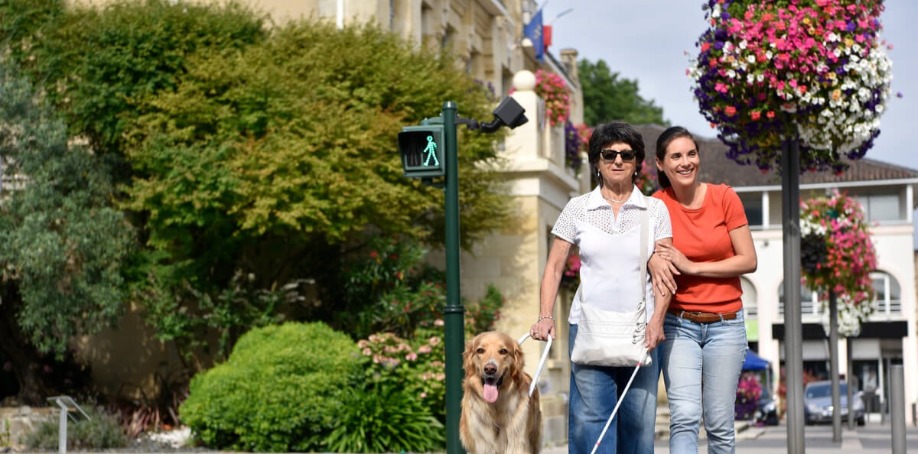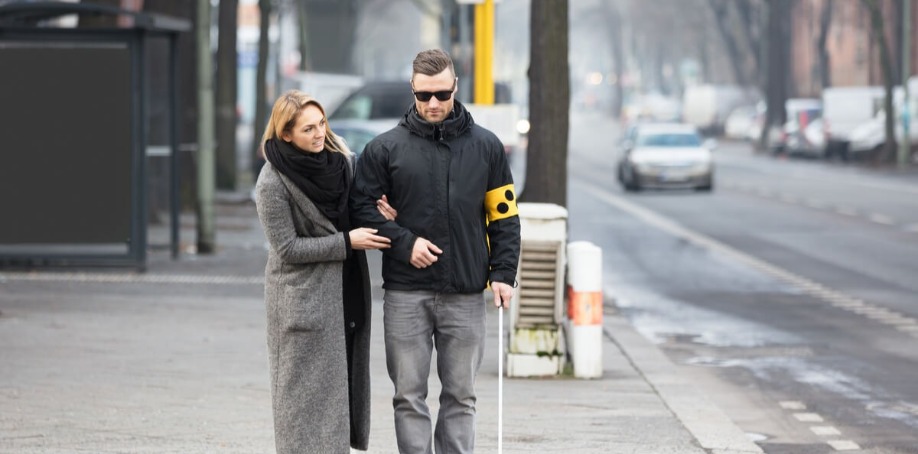
Everyone has experienced audio alerts. At crosswalks with accessible pedestrian signals, an automated message plays when it's safe to proceed: "Walk sign is on." When we're standing on the people-mover at the airport, we hear: "The moving walkway is now ending." For sighted people, these messages function as reminders. For blind or visually impaired people, they are critical safety cues.
Advances in technology make enhancing spaces with HQ audio easier than ever before. Designers can add discrete speakers without lines of cords and wires. And they can control those devices with one simple console.
HQ audio has the potential to enhance public spaces and make them more accessible for blind or visually impaired people. Let's dig into how that technology might be used.
Wayfinding Options
People with significant visual impairment may lean on memory to help them navigate. But Jarnail Chudge, design and innovation architect at Microsoft AI and Research, says most people can memorize about five routes. That limits their day-to-day travels.
Wayfinding tools offer information about where pedestrians are and how to get to their desired destination. Putting these tools in spaces like parks could help visitors move through unfamiliar locations without getting lost. And people won't need to stick to their memorized routes when they know a wayfinding system is there to help them through.
Parks and museums don't often provide these assets, says the team at accessibility app Right-Hear. Adding them could enhance the experience for visually impaired visitors, allowing them to obtain directions to specific exhibits and restrooms. An accessibility system allows visitors to move through independently, without asking for help.
Wayfinding's benefits don't end when people leave unfamiliar spaces. In areas of rapid construction, spaces that people once memorized could be completely different.
"As new places are continuously being made, the design discipline of wayfinding – providing the system of cues and tools that we each need to get from a Point A to a Point B – is called upon to help the naive users that are also continuously being produced," Mike Clark-Madison writes at The Austin Chronicle.
Audio systems that run on AoIP can be updated on a central console, and there's no limit on changes. Each time something new pops up in a neighborhood that could trip up or confuse a visitor, the audio signal could change accordingly.

Assisting in a Crisis
Audible cues can help people navigate an unusual space with ease, but even the most seasoned traveler can encounter the unexpected. When that happens, audible systems can play a crucial role.
Elizabeth Savage describes one such crisis for the New York Times. She'd lived with a visual deficiency for many years, and her walking routines were well mapped. But one day, everything went wrong, and she got lost.
"The morning rush of Midtown swirled around me as I tried to get my bearings. In that moment of disorientation and anxiety, power-walking New Yorkers bumping into me from what felt like all sides, I took a picture of the street sign with my phone and blew it up. I still couldn't tell where I was," she writes.
In a well-designed space, a lost visitor could push a button and listen to a description of the current location. It might be described by coordinates, landmarks or street names. That information might be just enough to help a lost person get back on the right course.
Audible systems can also be helpful in a time of crisis. When administrators need to get an urgent message to a community, in a park, airport, or public space, audio can be remarkably effective.
Security technologist Bruce Schneier highlights a 2013 incident in which an evacuation message was inadvertently posted on screens throughout the Tom Bradley International Terminal at LAX, with no accompanying audio. There were no reports of passengers evacuating. "So now we know: building evacuation announcements on computer screens are ineffective," he writes.
For people with significant vision difficulties, printed messages on a board are absolutely worthless. An audible alert could help them understand just what's happening now and what should happen next.
Enhancing Safety
Vision issues can make navigating public spaces treacherous. Is it safe to walk across the street? Should I keep waiting for a bus that might never come, even in an unsafe neighborhood? Audible cues can help the visually impaired.
Janet M. Barlow and Lukas Franck, writing for the American Council of the Blind, suggest that traditional crosswalk signs can be made more useful for people with vision issues. Rather than a simple audible "walk" command, for example, the speech message could explain that the walk sign for a specific street has been activated.
Parks with crossing paths could take the same approach. Audible systems could name the two roads and highlight if one is impassable due to weather, construction or some other temporary obstacle.
Transit systems can also provide helpful audible cues. In Vancouver, new transit stations have digital countdown displays indicating arrival times for the next buses. Passengers with impaired vision can access audio announcements by pushing a button, writes Kenneth Chan at the Daily Hive.
Augmenting the Experience
Public spaces are often filled with delightful scenes, and audible systems can help ensure that all visitors share in the spectacle.
Disney theme parks, for example, have long offered technology that describes the scenery pedestrians walk by. "Disney's handheld device offers these guests a new freedom to explore and interact with their surroundings in a way never before possible," writes Ricky Brigante, founder of Inside the Magic.
Disney's products work via headphones. Users rent a device and slip on headphones to enhance their visit through the park. They hear descriptions of exhibits they walk past, they hear cues that explain the rides in detail, and they can listen to guided tours of the parks.
Large-scale audio systems may not offer that same moment-by-moment description. They might be set up in fixed locations and triggered only with a button push. But the details contained in audio descriptions could be useful for people to understand the environment around them. Similarly, audio systems can help nature park visitors. A detailed description of a trail's terrain could be critical for hikers determining which trail to tackle.

Why Not Use an App or Braille Instead?
Developers have created apps for wayfinding, museum exhibits and park brochures. Apps that come on most phones could be used to help the visually impaired navigate their environment. But these tools aren't always ideal.
"Apps like Google Maps do have turn-by-turn directions, but they're not necessarily geared towards somebody with vision loss," says Jason Fayre, national lead of accessibility and assistive technology for the Canadian National Institute for the Blind. “So as you're walking with Google, it may tell you when to turn, but it's not going to tell you what streets you're crossing. It's not going to tell you about the intersections that you're coming up to.”
Someone using Google Maps knows their destination, but may need help completing the journey safely. Audio systems can fill in the gaps with detail about surroundings, hazards and landmarks.
Some apps include a significant amount of information, but site-specific apps must be downloaded. "Not all visitors are willing to download an app," writes Jennifer Gombeski, account executive at Concept3D.
Audio systems provide information for everyone, with no personal technology required. For people that can't or won't engage with a custom solution, a built-in set of speakers is a better choice.
Braille is of course a viable method to provide information to visually impaired people. But the National Association of City Transportation Officials suggests that audible announcements are preferred for transit riders with visual disabilities. A station with braille information display boards requires the user to know where the board is and then to find it in order to use it. Audio is simply accessible.
Best Practices
Audio systems allow designers to drench a space in sound, and with signals zoned, each person hears something a little different. But it's critical to design the system with the enjoyment of all in mind.
"Natural sounds are vital to your experiences in parks. They sharpen your senses and connect you to the park environment," writes the National Park Service. If your system is so loud that you drown out the birdsong or the roar of a waterfall, you risk depleting the experience for your visitors. Careful calibration is key.
Managing echoes is also important. "The sound distortion created by echoes can be difficult for people with vision concerns to manage. In certain configurations, it confuses the input on which they could otherwise rely for additional info about their surroundings," Dustin Eusebio, director of strategic partnerships at construction equipment rental company BigRentz, writes.
You may not be able to control the echo in a deep ravine, but you might use plants to help muffle bouncing sounds in a concrete skate park. A little creativity could help your visitors hear the right sounds at the right time.
Applying technology is also useful in echoing or loud environments. Chris Downey, accessible architect and founder of Architecture for the Blind, suggests that using ambient noise sensors may be helpful, as they can increase the announcement volume as ambient noise levels rise.
Images by: diego_cervo/©123RF.com, goodluz/©123RF.com, andreypopov/©123RF.com


